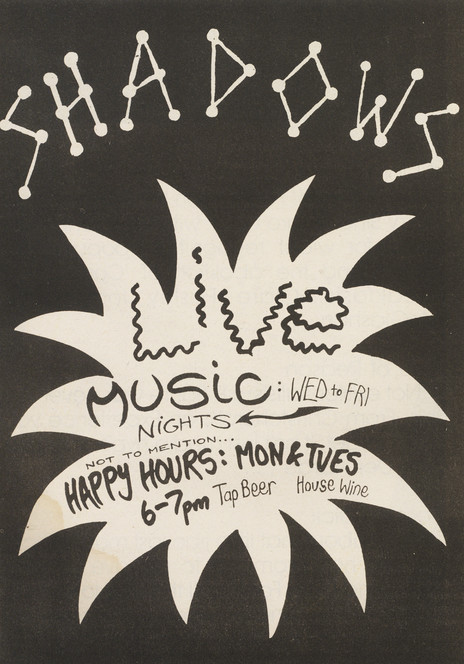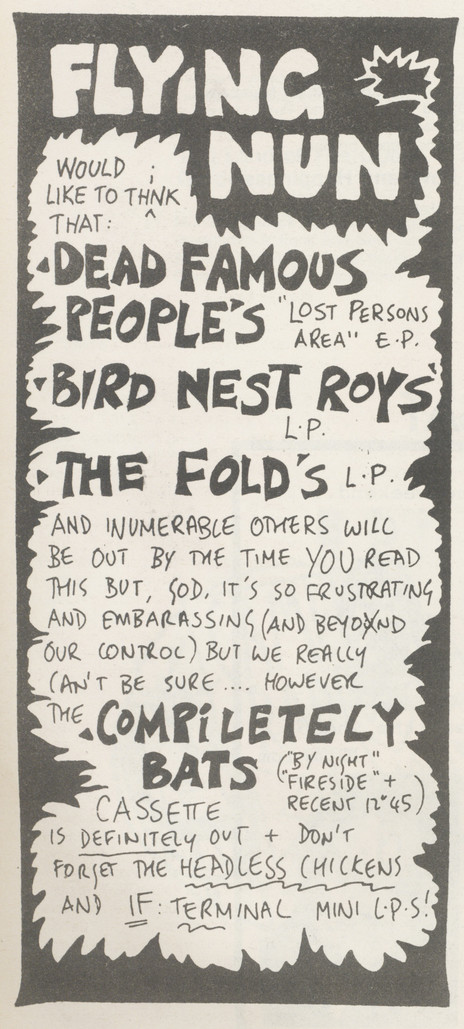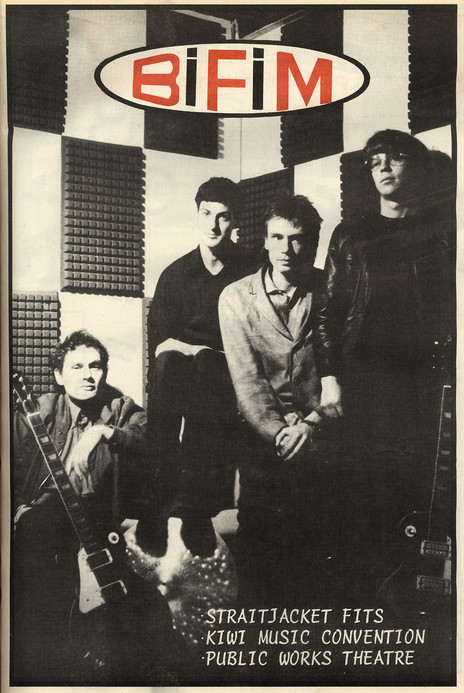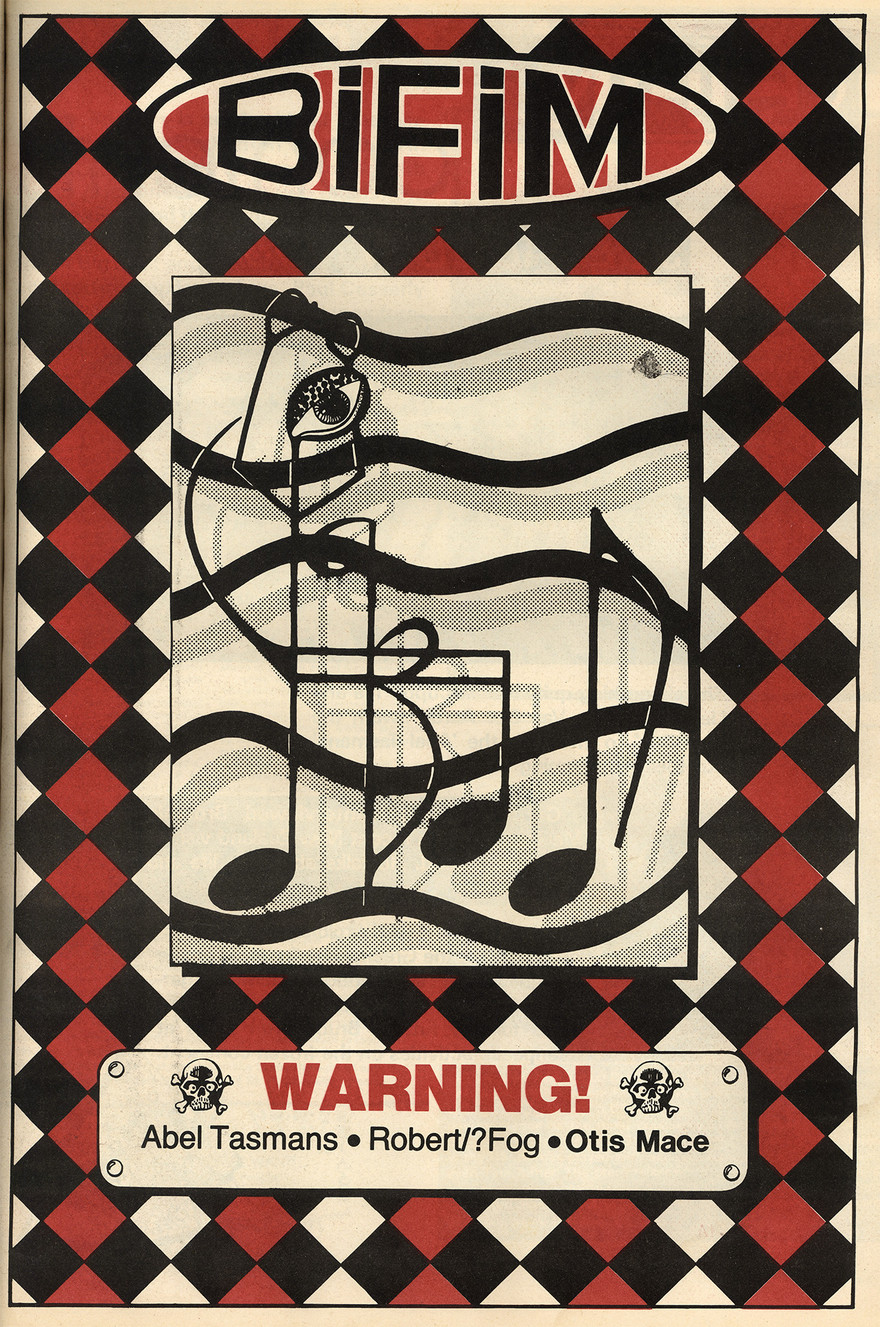By the mid-1980s Auckland student station Radio B(osom) had transformed itself into bFM, become a legal FM outlet, and a potent force in the city’s broadcasting. Where Auckland’s pop stations focused on a strict diet of US Top 40 hits – Barry Jenkin being binned demonstrated Radio Hauraki’s absolute refusal to engage with rock’s new, underground energies – bFM led the charge and was winning ever more listeners.
Debbi Gibbs, station manager in 1984, was promotions manager the following year, and launched its own, in-house magazine. The Book of BiFiM appeared in early 1985, a gloriously back-to-basics monthly magazine that led the charge for post-punk music. Its launch coincided with the first FM transmission by bFM on 91.8 MHz.

Book of BiFim, #8, 1986 - cover art by Chris Knox.
“Alternative Music Across Auckland” was both the radio station’s and the magazine’s semi-official byline and BiFiM certainly stood as the foremost Kiwi publication for such. Amazingly, for a free magazine that never compromised in championing the left field, BiFiM lasted for almost a decade, outgrowing its inky b&w origins and clunky name to become the very stylish, glossy Monitor magazine (while still free and part of bFM’s operations).
BiFiM published plenty of engaging, often irreverent journalism, championed local bands, many of which were otherwise unlikely to get a look-in, and captured the youthful energies of Auckland’s student/nascent hipster scene.
BiFiM’s early years exuded energy and a slapdash do-it-yourself aesthetic (very akin to Flying Nun’s approach to recording/promotion – the closeness emphasised by Chris Knox’s cover art contributions) before blossoming into a more mature, if still forthright, publication. Flying Nun bands dominated the local content: Straitjacket Fits appear to have been BiFiM’s favourite band (Gibbs became their manager in 1988, after her association with the magazine) and the arrival of Headless Chickens signals how, once based in Auckland, Roger Shepherd’s fledgling label would pursue a more abrasive rock culture.

Book of BiFiM #9, 1986. - cover by Debbi Gibbs
Looking though old issues I find all kinds of odd memory jogs. The listings and coverage of local bands includes several of whom I have no recollection (Joe 90, Dead Famous People, National Anthem, Olympic Sideburns) even though I was a diehard gig goer. Simon Grigg discusses his newly opened club, The Brat, pointing the way to a nascent Auckland club culture. And, of course, there’s the links to bFM – in those pre-internet days BiFiM was the best way to know who was on when. The radio shows schedule even features my kid brother, Neil Cartwright, hosting the Resurrection Punk Show, 8-10pm on Thursday nights (and writing reviews of new Hüsker Dü and Butthole Surfers imports for BiFiM, back when US hardcore was the cutting edge).

Weekly radio schedule, Book of BiFiM, 1985.

Drummer required for Dead Famous People. - Book of BiFiM, 1987.
BiFiM’s adherence to alt-rock was more perception than reality. Jonathan Ganley, editor in 1987, says: “A magazine can also have the diverse content that radio programming can’t easily achieve. We were aware of the local musical and cultural history that had gone before, and wanted it to be more widely appreciated. Stories about Ode Records, 1920s Auckland jazz, or the C’mon show were part of this effort. We also published interviews with musicians and artists as diverse as Herbs, Al Hunter, the Warratahs, The Front Lawn, poet David Eggleton, and the dance group Te Kanikani O Te Rangatahi. Each one had a different perspective on New Zealand life and they approached their music and art in a distinctive way.”
To BiFiM’s credit, in 1986 they published an in-depth interview with Merata Mita, covering many topics including the script she was then writing, which became her 1988 film Mauri. The feature on Terence O’Neill-Joyce of Ode Records is excellent; he issued more Polynesian recordings than any other New Zealand label. He describes how Prince Tui Teka kept Ode afloat.
The feature by jazz enthusiast Geoffrey Totton on the arrival of jazz and blues in Auckland after the end of World War One is fascinating. It details how Auckland’s first dance club was the Dixieland Cabaret on the corner of Queen and Waverley Street (later the location of Real Groovy Records). Another insightful feature has Kevan Moore, the producer of 1960s-era NZBC-TV pop programmes, discussing how he developed and shaped the likes of Let’s Go and C’mon (with Pete Sinclair as the immaculately groomed host). The likes of Rip It Up and In Touch never ran such historic features.

C'mon 68 - The Chicks on the cover of BiFiM, 1987.
Advertising came from Revival Records (then on Victoria Street and a great place to dig for old soul and rock LPs at very reasonable prices), Flying Nun (of course), Kingsley Smith musical instrument shops, plus forthcoming local and international concerts: The Cramps, New Order, Paul Kelly & the Coloured Girls ...

Revival Records ad, drawn by Barry Linton, from Book of BiFiM, 1985.

Kingsley Smith music shop ad, BiFiM, 1987.
An advertisement for The Gluepot makes me swoon in memory of great nights spent both upstairs and down at the 3 Lamps Mecca, while an ad for doomed music festival Neon Picnic reminds of a time when there were no music festivals in New Zealand.

Gluepot listings, BiFiM, 1987.
BiFiM documented Auckland’s student/alternative rock scene as it developed. The magazine’s increasing confidence reflected a city where there were fewer fights on the dancefloor yet more excitement and glamour. As with bFM it helped open up possibilities: respect to all involved.
Voices Of BiFiM
Debbi Gibbs (BiFiM founder/editor)
“I had been the station manager of bFM for a couple of years and my greatest ambition and achievement was to get the station to the FM spectrum. Mission accomplished, I stepped down as station manager and appointed myself marketing manager. BiFiM and numerous gigs were my attempt to market the station and engage our audience.
“Initially I was writing, editing, typing all the contributions and laying the thing out on my bedroom floor. The station gave the magazine a teeny bit of seed money and then advertising paid for the printing. None of the contributors got paid – even the brilliant cover artists. There were no sub editors or designers. After the first issue I managed to talk Craccum into letting me use their dark room to print the photos and then, after the second issue, they let me lay out the magazine in there on a weekend. The contributions came from whomever I could beg or bully into writing something.

Shadows advert from BifiM, 1987.

Last Laugh recording studio, Vulcan Lane, Auckland - BIFIM 1988.
“BiFiM was initially intended as a marketing tool for bFM and a way to extend our engagement with both our audience and the local music scene. I was also promoting gigs and the gigs were meant to do the same thing – promote the station and engage our audience and the music community. I never saw it as a standalone magazine. Looking back on it is very funny: the typesetter would only do one shot at the body text so if there were any mistakes I had to cut it up and rearrange individual letters, and all the headlines are just my handwriting.
“Hardly any of them were given out on campus – Ian Dalziel distributed them mainly. I think he was distributing Rip It Up and/or Flying Nun and I would just add to his load. What a honey – no idea why he did that.”
Andrew Charles Bishop (bFM station manager 1985)
“Debbi, who was the driving force behind the FM transformation, came up with the idea of an in-house fanzine to provide listeners with information such as on-air times and special show timetables, along with columns by DJs and reviews etc, similar to the station’s website today.

The 1984 Radio B Top 50, Book of BiFim #1, 1985.
“At the time the AUSA’s once B-friendly Craccum editors had been replaced by a less enthusiastic team – it was an almost wholly political publication with some AUSA club info and had little interest in the local music scene. Our access to free publicity vanished so publishing our own news seemed the best plan.

Book of BiFiM #13. - Cover art by Chris Matthews
“Articles, photos and reviews were submitted mostly by station staff and special show hosts. Initially, we had no computers or even a typewriter and the first issues were planned and laid up all over the floor of Debbi’s flat. The big difference between BiFiM and Murray Cammick’s Rip It Up, besides the hand-written articles, was that RIU was publishing articles about a more commercial range of music. BiFiM was very local-content heavy with cover art by the same musicians/artists who were also producing covers and posters for local bands.
“BiFiM began developing with a lot of support from the bands, record labels, venues, cafes and clothing labels. It was basically a physical representation of what we were broadcasting.”

Flying Nun ad, drawn by Chris Knox, Book of BiFiM, 1987.
Ian Dalziel (design, distribution)
“I was at the time working at Rip It Up, living with Doug Hood, Chris Knox, Barbara and family at Hakanoa Street, also helping Doug with Windsor/Looney Tours and Chris with Flying Nun wherever needed. Debbi needed a hand with some of the basics of putting a print-ready mag together, I just answered her questions and helped where needed, I may have done one of the gig guides or show guides or some such. There may have been alcohol involved and deadlines – contiguous recollection may be sporadic and enhanced or dropped out altogether.”

That time Martin Phillipps opened for the Flamin Groovies: Looney Tours monthly menu - Book of BiFiM, August 1986. Artwork by Ian Dalziel.
Jonathan Ganley (photographer, writer, editor)
“I was involved with BiFiM magazine between 1985 and 1988 as a photographer, writer, and production wrangler. I was the editor in 1987 and we made changes to the fonts and layout to improve the appearance of the magazine. We changed the format from folded A4 to flat A3, and emphasised photographs. A young, enthusiastic and opinionated team created a publication to support BFM and promote the kind of music that was played on air. Everyone on the BiFiM team had wide musical tastes, and most also did shows on BFM. The station playlists featured mostly ‘alternative’ rock, and a lot of New Zealand music was played.

Straitjacket Fits, BiFiM, May 1987. - Photo by Jonathan Ganley
“I think BiFiM was very successful in covering many aspects of the New Zealand music scene, particularly independently released and ‘alternative’ music. The magazine covered bands and recordings from labels such as Pagan, Jayrem, South Indies, Failsafe, F-Star, Onslaught, Xpressway, and particularly Flying Nun. Roger Shepherd’s label was gaining recognition with some exceptional bands and releases, and BFM and BiFiM embraced the Flying Nun sound and attitude. Straitjacket Fits featured on a BiFiM cover in May 1987, photographed while they were recording their first EP. It was obvious they were going to be great. History shows we were right to believe their music, and the ‘alternative’ music of their contemporaries, was worth seeking out, playing and promoting.”
Paul Casserly (writer, editor)
“Not sure of the timeline but I’d been programme director and news editor and then had a stint as mag editor when it was decided to change the name to Monitor. I loved the original Chris Knox zine-era BiFiM – it probably became a bit bland under my watch, but was an outlet for a bunch of people, including myself, to have a go. It was all gut really, planning was never a bFM strength, all the cool stuff twentysomethings are into. It was pretty narrow and random probably, but the better writers gave their favourite acts a good push. It was a blast and I'm ever grateful for the opportunity and memories. The long weekends doing layout in the pre-computer age with a scalpel are definitely memorable.

DJ Greg Johnson. - BiFiM, November 1987. - Photo by Paul Casserly
“Once, during a long layout weekend, a guy with a tattoo on his face that looked a lot like the word “fuck” done in a mirror, if you know what I mean, came up to the station and along to Craccum where we were laying out the mag, and said “are guys with Radio B?” We nervously said yes, and he handed me and a mate (I think it was Greg Johnson) $50 – our weekly wage at the time – and said, ‘this is for you guys. BiFM saved my life while I was in jail!’ In hindsight, I think he meant for us to give it to the station but I recall that we ate well that weekend and possibly bought some casked wine and weed. Fairhall River claret rings a bell.”

Ted Brown's The Tunnellers on the cover of BIFIM, February 1988. - Photo by Ian Brown

Straitjacket Fits, BIFIM, November 1988. - Photo by Jonathan Ganley
Michael Lamb (editor)
“In 1989 I was editor of Craccum. Our office was next door to 95bFM. Monitor was slick. Paul had done an amazing job with it. But, at the end of 1989, something went awry and he was pushed from the job. With my tenure up at Craccum, Simon Laan (bFM station manager) wandered down the corridor and asked me if I wanted the gig. Hell yeah! They were big shoes to fill. Paul really had set the bar super high.
“As the official mag of bFM we supported the station in any way deemed useful: ad crossovers, programme listings and all that functional stuff. I soon got to know who the regular contributors were and managed to persuade most of them to carry on under my auspices.
“Music, of course, was our main beat. In tandem with bFM we were a pretty good guide to what was happening in the independent, alternative scene. The mag had pulling power with the music companies so we were offered pretty good interviews – phoners with UK, US, or Australian musicians, plus of course NZ musos in person.
“When Liz Tan took over as station manager the magazine was seen as a luxury bFM didn’t need, not core business, getting too far out from under the station’s direct control. Certainly, various forces were lining up against us towards the end of 1991. Then it all came to a head when we didn't have enough ad income sorted for the first issue of 1992. That was not good. A little bird landed on my window sill one morning and passed on the rumour they were going to shutter the mag. Call me biased, but BiFiM/Monitor was a great mag.”
--

Book of BiFiM #1, 1985.

Book of BiFiM #2, 1985. - Cover art by Chris Knox.

Book of BiFiM #3, 1985. - Cover art by David Mitchell

Book of BiFiM #4, 1985. - Cover art by John Collie

Book of BiFiM #5, 1985. - Cover art by David Mitchell

Book of BiFiM #6, 1985. - Cover art by Smooth Crew.

Book of BiFiM #10, 1986. - Cover art by Hamish Foote

BiFiM, July 1987. - Cover art by Michelle McGill

Billy Bragg, BiFiM, March 1987. - Photo by Jonathan Ganley

Dick Driver, BiFiM, August 1987. - Photo by Chris Forster

BIFIM, March 1988. - Photo by Marsupial

Not Really Anything, BIFIM, August 1988. - Photo by Stuart Page

BIFIM, October 1988. - Photo by Deborah Smith

BIFIM, December 1988. - Cover art by Colin McCahon
--
Note: The Book of BiFiM was the name of the magazine in 1985 and 1986; in 1987 it was BiFiM; and from 1988 it was BIFIM.
--
Read more: Monitor magazine